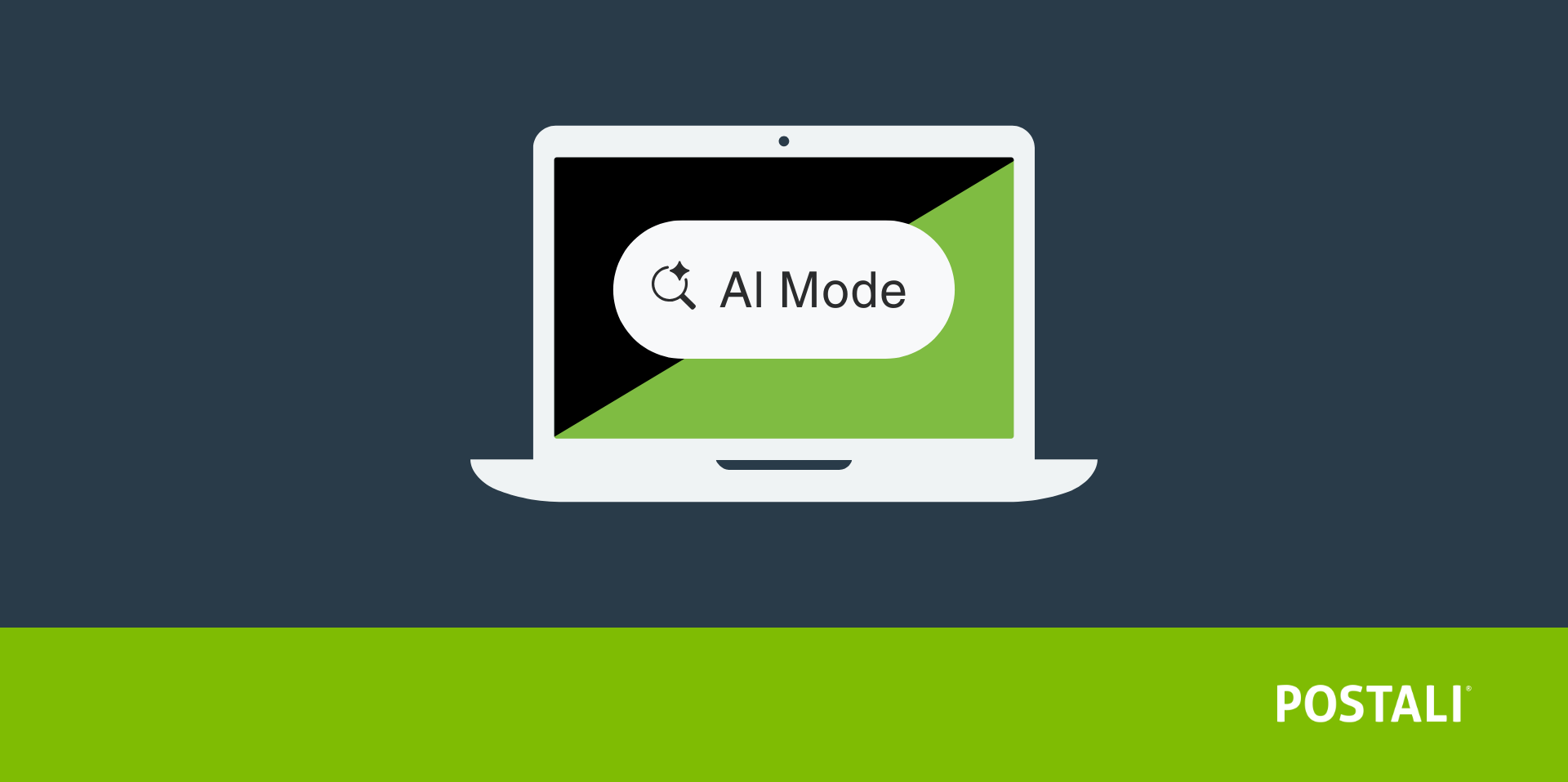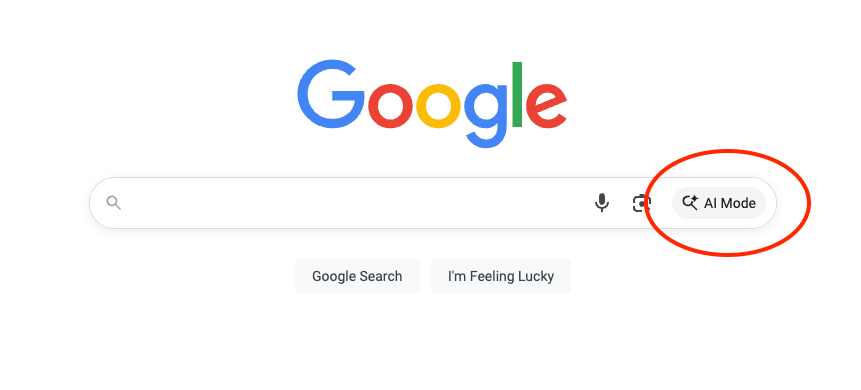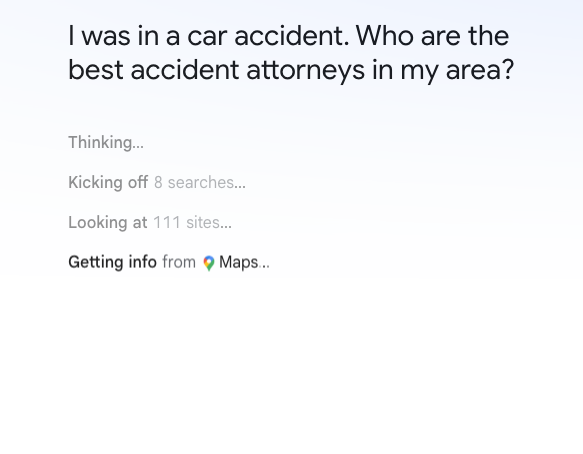Digital Marketing, SEO

If you feel like Google’s search results look different every time you check them, you’re not wrong. Over the past year, Google has accelerated its shift toward AI-powered search, introducing new features that fundamentally change how users interact with information. One of the most significant of these changes is the introduction of AI Mode, an experience that moves Google from a search engine into an Answer Engine.
For law firms and legal marketers, this is much more than a superficial update. It affects where your law firm shows up, how potential clients find you, and how many clicks you can expect from search results. At Postali, a legal marketing agency, we’ve been testing strategies to make sure our clients’ websites don’t just survive these changes but thrive.
This guide breaks down what AI Mode is, how it works, and what law firms should be doing now to stay ahead.
What Is Google’s AI Mode?
Google AI Mode is a new search experience that uses artificial intelligence to provide conversational, in-depth answers directly within Google Search. The “turn-based” chat interaction will be familiar to those who have adopted ChatGPT and Perplexity. Unlike traditional search results, AI Mode lets users ask follow-up questions, see AI-generated summaries with cited sources, and “dive deeper” into topics without leaving the search page.

From SGE to AI Overviews to AI Mode
Google has been building toward AI-powered search for years. The journey started with Search Generative Experience (SGE), rolled out in 2023 as an experiment. SGE used generative AI to create summaries at the top of search results. While experimental, it signaled where Google was headed.
In 2024, Google launched AI Overviews in the U.S. These snapshots continue to appear at the top of results for many queries, summarizing answers directly in the search results.
Now we have AI Mode, Google’s boldest step yet. Instead of static summaries, AI Mode allows users to “enter” a conversational search environment, asking follow-up questions and receiving deeper, more contextual responses.
AI Mode vs. AI Overviews: What’s the Difference?
- AI Overviews: Quick, static answers at the top of traditional search results.
- AI Mode: A full-screen, conversational interface where users can ask layered questions and refine their search without leaving Google.
Think of it this way: AI Overviews are like an upgraded featured snippet, while AI Mode is more like a built-in chatbot for Google Search.
Why Google Launched AI Mode
Google’s move isn’t just about improving results – it’s about remaining competitive. With tools like ChatGPT and Perplexity AI capturing users’ attention, Google needed to evolve beyond the traditional “ten blue links.” AI Mode keeps users on Google longer, provides a more intuitive and customized experience, and opens the door for future monetization (yes, ads are coming).

How AI Mode Works
Query Fan-Out: How Google Sources Information
When someone asks a question in AI Mode, Google doesn’t just pull from one site. It “fans out” the query to multiple sources, cross-references them, and generates a consolidated response. For law firms, this means you don’t need to hold the top ranking to appear in AI Mode – but your site must demonstrate topical authority, trustworthiness, and be structured in a way Google’s AI can interpret. Just as importantly, your firm should maintain strong visibility and a positive reputation across third-party sites, since Google often pulls from multiple sources when building its answers.
Behind the scenes, this process builds on Google’s AI retrieval technologies like MUM (Multitask Unified Model) and MuVerA (Multi-Vertical Embedding Retrieval Architecture). These models allow Google to connect information across multiple verticals – from websites and business profiles to news articles and directories – and assemble it into a single answer.

Conversational and Context-Aware Search
AI Mode is built for conversational search. A user might type: “What are the steps to file for divorce in Ohio?” Then follow it up with: “How long does it usually take?” and “What documents do I need to bring to a lawyer?”
This layered, back-and-forth (or turn-based) experience mimics how a potential client would talk to a lawyer, which is precisely why law firms need a content strategy that anticipates these kinds of follow-up questions.
Personalization and Search Intent Play a Factor
Google has always tried to understand user intent, but AI Mode takes it further. Traditional search used personalization signals to re-rank and prioritize specific results in SERPs. AI Mode uses context, such as previous searches, phrasing, and location, to shape the answer itself. For example, a query like “car accident settlements” may generate an AI summary explaining factors that affect compensation, while “hire a car accident lawyer near me” is more likely to surface local law firm profiles, a map result, and tips for hiring an attorney.
For law firms, this reinforces the need to address both research-focused questions (informational) and ready-to-hire searches (transactional) – because AI Mode adapts its responses based on where a user is in their journey.
Another key difference is that AI Mode encourages users to phrase searches in natural, conversational language. Instead of typing “Ohio divorce lawyer fees,” a potential client might ask, “How much does it cost to hire a divorce lawyer in Ohio?” Law firm content needs to reflect this style of questioning, covering both broad topics and the kinds of long-tail queries that clients actually use in conversation.
The New SERP Experience: Carousels, Citations, and Expanding Answers
AI Mode reshapes how search results look and behave. Instead of a static list of links, it often includes:
- Carousels of cited sources with logos and page titles
- Expandable answers that let users “dive deeper” into specific aspects of a topic
- Rotating citations, where sources appear or disappear depending on the query or follow-up interaction
- Integrated maps and local packs for service-based or “near me” searches, pulling directly from Google Business Profiles
The challenge is that AI Mode’s layout isn’t consistent. It can shift based on the query, device, location, or even Google’s testing. That means visibility can be variable from one search to the next.
Click behavior has also shifted. Instead of only choosing a traditional blue link, users can engage with inline citations, carousel cards, or map results. This complicates performance tracking and pushes law firms to think beyond traditional clicks.
For law firms, the upside is that more firms can surface in results, even if they don’t rank #1 organically. The downside is volatility: your firm might be visible one moment and gone the next, making consistent optimization of your website and Google Business Profiles (GBP) more important than ever.
How AI Mode Impacts Search Behavior
Declining Click-Through Rates (CTR)
Because AI Mode provides detailed answers upfront, fewer users are clicking through to websites. This drop is most noticeable for informational queries like “average car accident settlement in Ohio,” where the AI summary often satisfies the user’s question without requiring another click. For law firms, that means content aimed purely at answering broad questions may not drive as much traffic as it once did, even if your firm is cited as a source.
A Continuing Uptick of Zero-Click Searches
A zero-click search happens when Google answers a query directly on the results page, so the user never clicks through to a website. This has been happening for years with things like weather forecasts, sports scores, and calculators. AI Mode accelerates this trend by giving potential clients detailed answers upfront – sometimes enough to delay, or even skip, visiting your site altogether.
Additionally, a significant percentage of links provided within Google’s AI Mode responses link to additional Google properties (Maps, GBPs, etc.). Even users searching your brand name may access your contact information without visiting your site.
Conversational Search Is the New Normal
AI Mode is shifting user behavior toward more natural, multi-step questions. Instead of short, keyword-heavy searches, people are asking Google questions the way they would in conversation: “Do I have to go to court after a car accident?” or “What’s the fastest way to file for divorce in Ohio?” This change creates opportunities for law firms that publish content addressing these client-style questions directly, but it also raises the bar.Your content has to feel useful and authentic, not just keyword-optimized.
Longer Research Journeys Before Contact
For law firms, AI Mode means potential clients might research extensively before ever calling. Instead of clicking on the first search result, they may spend several queries gathering context, or asking follow-up questions about legal processes, a firm’s reputation, attorney experience, or even pricing. That makes brand visibility across multiple queries more important than ever with a clear need to address topics like experience, reputation, and pricing on their websites.
SERP Volatility and Ranking Shifts
AI Mode introduces a new kind of volatility compared to traditional organic rankings. Instead of static positions, citations within AI-generated answers can rotate in and out depending on the query phrasing, follow-up questions, or even the interface Google decides to show. A page that appears in the citation carousel for one user may be absent for another, even when searching the same topic.
For law firms, traditional ranking metrics are no longer enough. Success in AI Mode is less about holding a fixed position and more about being consistently eligible as a trusted source across different variations of a query.
Local and Transactional Queries: The Role of Google Business Profiles
When someone searches with local or service-based intent, queries like “divorce lawyer near me” or “Columbus car accident attorney,” AI Mode often blends its generated summary with map results or firm listings pulled directly from GBPs.
That makes your GBP a critical piece of visibility in AI Mode. If your profile is incomplete or inconsistent, your firm may not appear at all, even if your website is well-optimized. We’ll cover how to strengthen your GBP later, but the key takeaway here is that AI Mode treats it as a primary data source for transactional and “near me” queries.
Tracking Challenges in Google Search Console and GA4
Although AI Mode traffic data has been added to Google Search Console, GSC and GA4 don’t yet capture the complete picture of how users interact with AI Mode. Impressions and clicks inside AI-generated results aren’t always logged the same way as traditional search results, leaving law firms with reporting blind spots. This can make it look like visibility is declining when, in reality, your firm may still be surfacing inside AI Mode. At Postali, we’re actively testing new ways to measure AI-driven performance and building strategies to work around these gaps.
What Law Firms Can Do Right Now to Stay Visible in AI Mode
While a debate continues over what to call this work (SEO, AEO, or GEO), there are actionable steps law firms can take now to strengthen their visibility, prepare for future changes, and ensure they remain part of the conversation in AI-powered results.
On-Site SEO Strategies
Strong on-site SEO remains the foundation of visibility in AI-powered search. Google’s AI Mode favors websites that provide depth, clarity, and technical accessibility. Here’s how law firms can strengthen their on-site presence to improve their chances of being cited in AI-generated answers.
Create Comprehensive Content That Anticipates Client Questions
Thin practice area pages won’t cut it. AI Mode pulls from multiple sources and favors content that goes beyond surface-level explanations. On a personal injury website, cover subtopics like medical bills, insurance claims, timelines, and settlement factors, but also think like a client. What questions would they ask in a consultation? Queries like “How much does it cost to hire a lawyer?” or “Do I have to go to court?” should be answered clearly in your content. By combining topical depth with real-world client concerns, you increase the chances of being cited in AI-generated responses (and provide better content for your users).
Build a Strong, Accessible Site Structure
Google’s AI can only use what it can easily understand. A clear site structure helps AI Mode identify your content, connect it to related topics, and surface it as a trusted source. That means intuitive navigation, well-organized practice area pages, and internal linking that shows how topics relate. Technical factors also matter – fast load times, mobile optimization, and clean code make your site easier to crawl and more likely to be cited in AI results.
Leverage Structured Data and Schema
Schema markup provides Google with a roadmap to your site, helping AI Mode understand your attorneys, practice areas, office locations, and even FAQs. The clearer this data is, the easier it is for Google to pull your firm into AI-generated answers, carousels, or local results. For law firms, schema types like LegalService, LocalBusiness, Person (for attorney bios), and FAQPage can all strengthen visibility. At Postali, we implement schema across our clients’ sites to maximize their chances of being included in AI-driven search results.
Off-Site SEO and Reputation Management
Your online presence extends well beyond your website. Google’s AI Mode draws from business listings, reviews, and trusted third-party directories when generating answers. By strengthening these off-site signals, law firms can build credibility and improve their chances of being cited in AI-driven results.
Optimize Your Google Business Profile
AI Mode frequently pulls information straight from Google Business Profiles (GBPs), especially for local or “near me” searches. That means your GBP isn’t just a directory listing – it’s often the first impression potential clients see inside AI results. A fully optimized profile includes complete business information, accurate categories, detailed services, updated hours, and high-quality photos.
For law firms, even small details like listing practice areas under services or selecting the right primary category can be the difference between showing up in AI results or being left out. That’s why local SEO for law firms is so critical – an optimized profile can make or break your visibility in AI Mode.
Manage Reviews and Online Reputation
AI Mode doesn’t just reference your website; it frequently pulls information from reviews on Google, Yelp, Avvo, and other third-party sites. These reviews can shape how your firm is presented in AI-generated summaries and whether you’re surfaced in local results at all. A poor or inconsistent review profile can limit visibility, while strong ratings and recent feedback can help position your firm as a trusted source. Reputation management for law firms is no longer optional; it’s a critical part of being competitive in AI-powered search.
Ensure Consistent NAP Across Directories
Google’s AI cross-references multiple sources when generating results. If your firm’s name, address, or phone number (NAP) is inconsistent across directories, bar associations, or legal listings, it can create confusion and reduce trust signals. That inconsistency may not only hurt local SEO but also limit your eligibility to appear in AI Mode results. Keeping your NAP data clean and consistent everywhere strengthens both your traditional local rankings and your visibility in AI-driven search.
Be Visible on Trusted Sources Beyond Your Website
When Google’s AI fans out a query, it pulls from a variety of sources. not just your firm’s website. Legal directories, bar association listings, and local media coverage are all places Google relies on to cross-check information and surface credible answers. For law firms, building visibility across these trusted sources increases the likelihood of being cited in AI-generated responses and reinforces your authority online. It’s not enough to have a strong website; your presence needs to extend across the broader ecosystem Google uses to validate information.
These off-site signals also tie into Google’s E-E-A-T framework – Experience, Expertise, Authoritativeness, and Trustworthiness. AI Mode favors information backed by credible, corroborated sources, which means law firms need authority that extends beyond their websites. Listings in bar associations, features in legal directories, and mentions in reputable media all strengthen your eligibility to appear in AI-generated answers.
The Future of AI in Google Search
AI Mode is only the beginning of Google’s transformation. The search experience is quickly moving from simple answers toward actions and deeper engagement. Here are some changes law firms should be prepared for in the near future.
From Search to Action: The Rise of Agentic AI
One of the most significant shifts still on the horizon is Agentic AI. While AI Mode today focuses on answering questions, Google is already moving toward a version of search that doesn’t just inform users: it takes action for them. Agentic AI will go beyond providing answers and start completing tasks like booking appointments, sending emails, or scheduling consultations directly. For law firms, this means your site needs to be crawlable and AI-friendly, with clear booking links, consultation forms, and contact pathways that AI can surface and use. Voice assistants are also part of this future. Potential clients may soon be saying, “Hey Google, schedule a consultation with a personal injury lawyer in Columbus,” and expect it to happen instantly.
“Dive Deeper in AI Mode”: What It Means
Google is actively encouraging users to spend more time inside AI Mode. A “Dive Deeper” button often appears at the end of AI Overviews, signaling that Google wants searchers to continue their journey within the AI interface. For law firms, this reinforces the importance of creating content that covers not only broad topics but also the natural follow-up questions clients are likely to ask.

Growing Prevalence of AI Overviews
Expect AI Overviews and AI Mode to appear more frequently across different query types. Even if your firm hasn’t seen them often yet, the trend is clear: AI-generated results are expanding into more areas of search.
Ads in AI Results Are Coming
Google has already begun testing ads inside AI Overviews. For law firms relying on Google Ads, this could reshape campaign strategy, since ads may soon appear alongside, or even within, AI-generated summaries.
Preparing Your Law Firm For the Future of Search
Why Law Firms Can’t Ignore AI Mode
Google’s AI Mode isn’t a passing experiment; it’s the future of search. Law firms that don’t adapt risk losing visibility to competitors who are already optimizing their websites, Google Business Profiles, and online reputations for AI-driven results.
How Postali Helps Firms Stay Ahead
Law firms should revisit their SEO strategies now, before their visibility begins to drop. Focus on strengthening topical authority, increasing entity-based relevance, and creating semantically rich content. As Google’s search experience continues to evolve, firms partnering with agencies that specialize in the legal vertical and stay ahead of changes and new products like AI Mode will have a distinct advantage.
At Postali, we’ve prepared our clients for this shift and the next. Our strategies are designed to help law firms succeed in AI-powered search, including:
- Implementing structured data across websites
- Enhancing GBP optimization to capture local queries
- Monitoring AI-driven visibility beyond traditional rankings
- Ensuring technical site health so AI can easily crawl and cite content
AI Mode is changing how potential clients find and evaluate attorneys. If you want to stay visible in this new landscape, the time to act is now. Contact Postali today to learn how we can help your firm thrive in the AI era.

